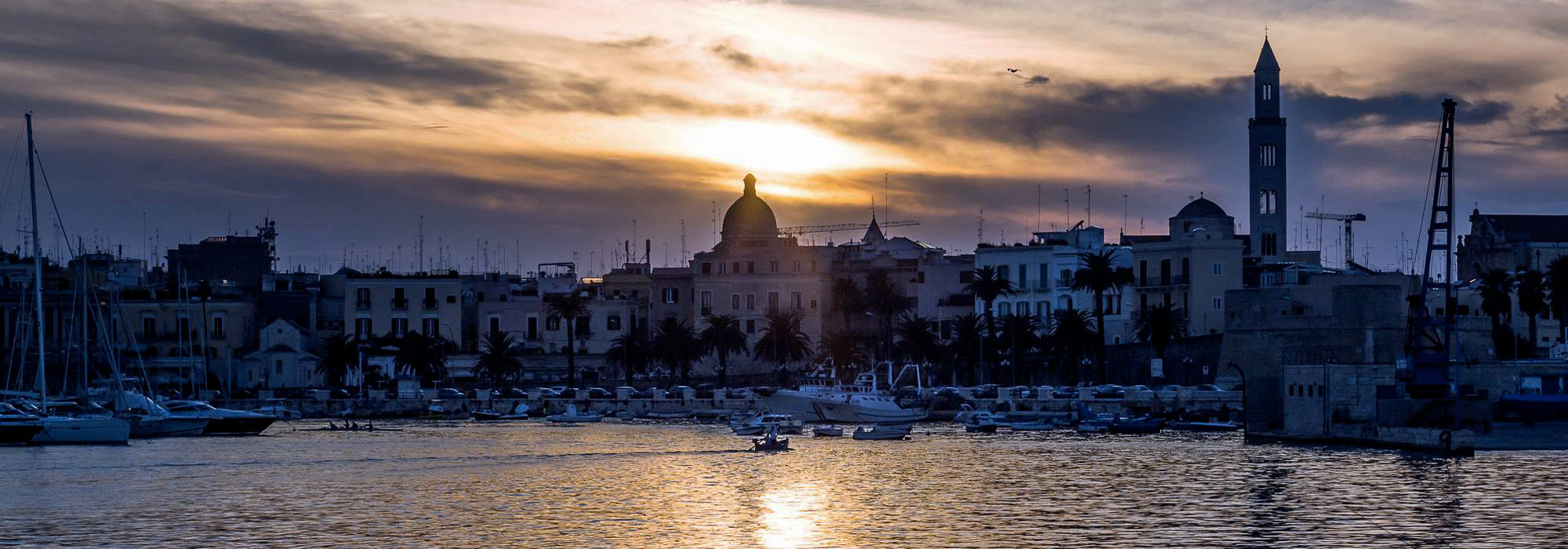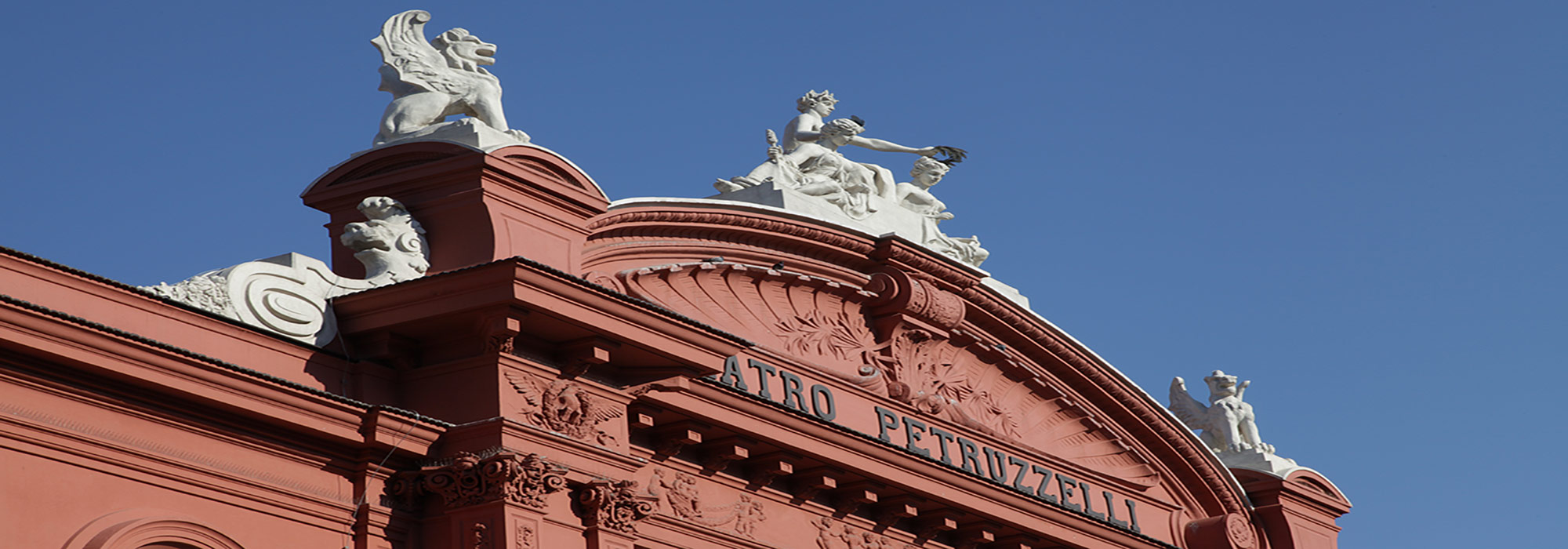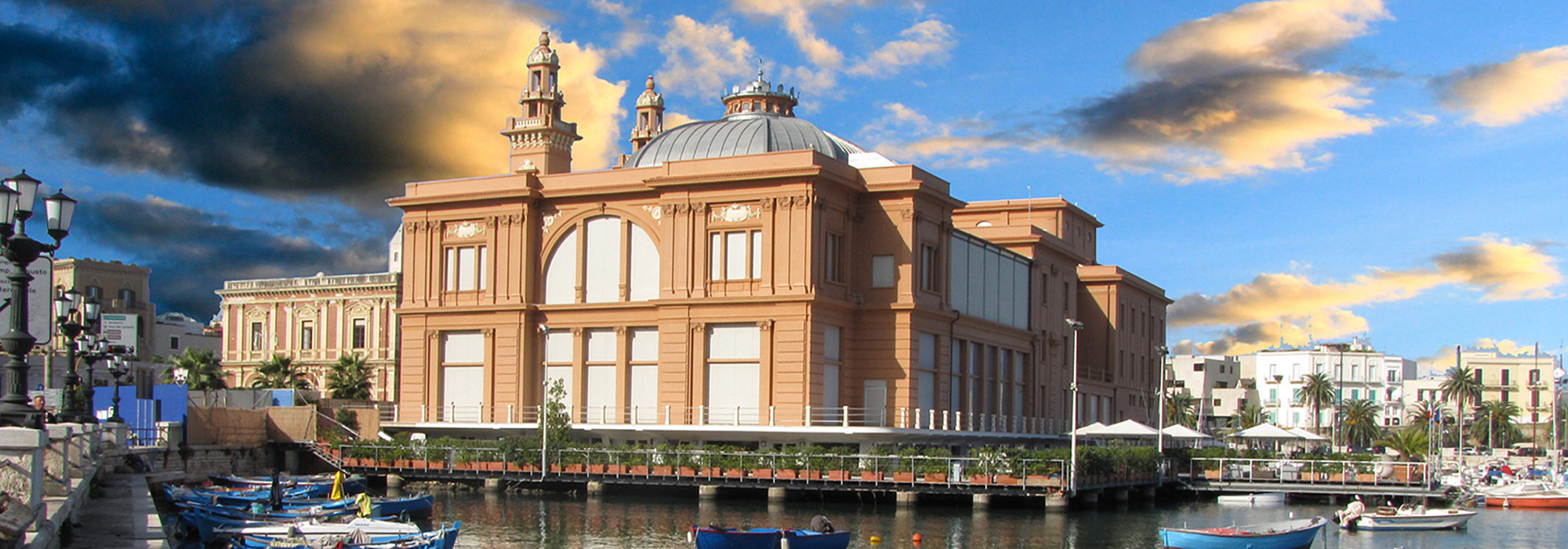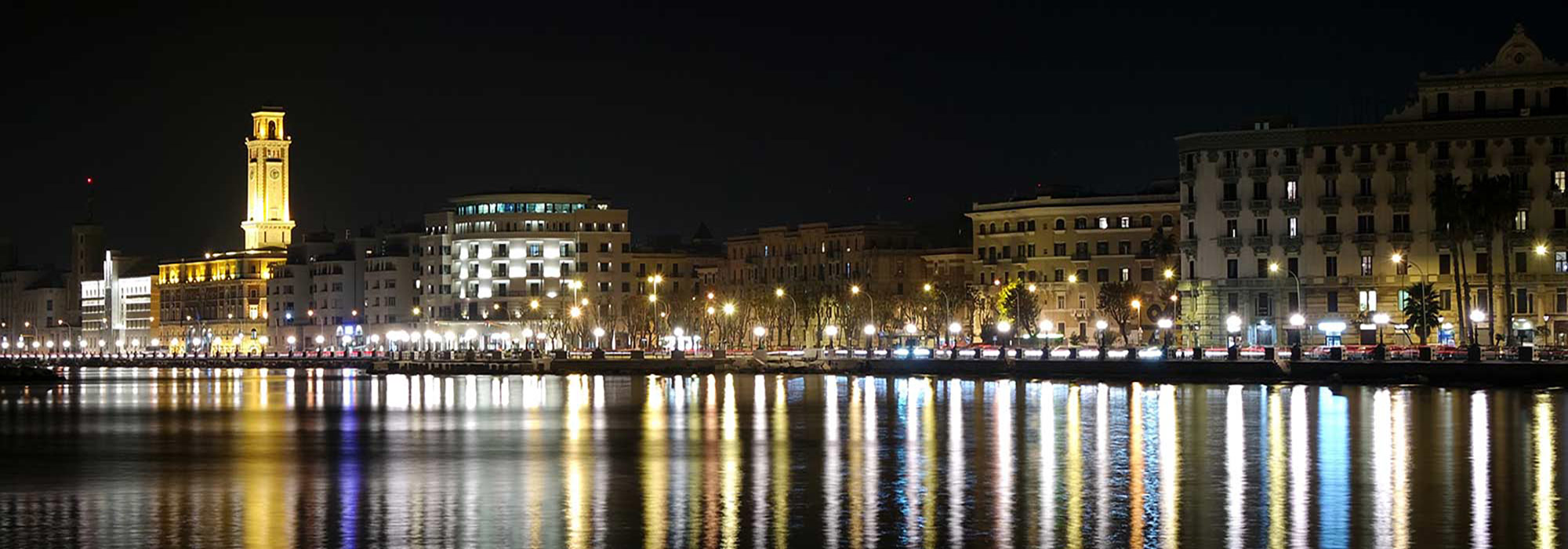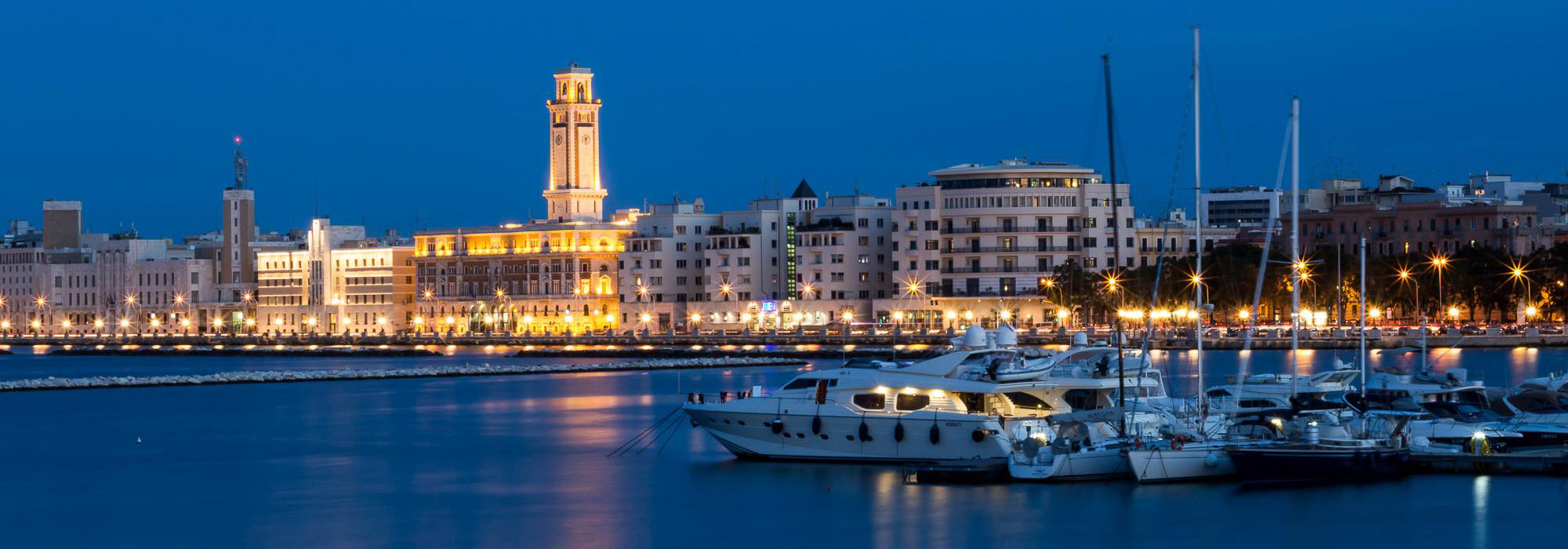Sorrounding
The capital town of the Region lies on the Adriatic coast. The town has the shape of a bird with open wings, whose head forms the nucleus of Bari Vecchia, the old town.Bari was annexed to the Roman Empire in the 3rd century B.C. and over the ages it was an Arab Emirate, later conquered by the Longobards, Bizantines and Saracens. Once the base of the Roman Empire’s fleet for the Orient, the urban structure of the old town is arranged around the Catapan Court.
After the remains of Saint Nicholas were stolen and the homonymous Basilica was built, Bari became a centre of Christianity from where the Crusaders
could leave for the Orient. Ruled by Normans, Angevins, Aragons and the Spanish, the town first expanded outside the old part in 1813.
Important monuments in town include the Basilica of San Nicola, housing the remains of the patron saint, and the Norman-Swabian Castle, built under the orders of Frederick II for purposes of defence. Places of interest in the old part of the city are the piazza Mercantile and the Colonna infame, once used as a pillory for insolvent debtors. The “Old Bari” district is surrounded by the majestic Lungomare Imperatore Augusto and the splendid Piazza del Ferrarese. More modern buildings worth a visit are Teatro Petruzzelli and Teatro Margherita. There are also many churches on the reefs and hypogeum cut out of the rock and subsoil. These include: the church of St. Candida and the temple of St. George. Museums which have to be mentioned are the Archaeological Museum, the Provincial picture gallery, the Civic History museum and the Botanical Gardens Institute. Important events include the festivities of Saint Nicholas, the patron saint of the town, between the 7th and 9th of May, and the exhibitions at the Levante Fair.
Egnazia ruins
 Gnatia (also Egnatia or Ignatia in Greek) was an ancient city of the Messapi, and their frontier town towards the Salentini. It is located near the modern Fasano.
Gnatia (also Egnatia or Ignatia in Greek) was an ancient city of the Messapi, and their frontier town towards the Salentini. It is located near the modern Fasano.
The first settlement known in the place dates from the Bronze Age (15th century B.C.). In the 11th century B.C. it was invaded by the Iapyges, while the Messapic era of the town (as well as for the whole Salento) began in the 8th century B.C., to end in the 3rd century B.C., with the Roman conquest.
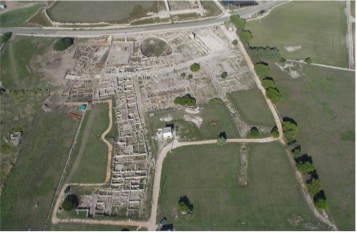 Under the Romans, it was of importance for its trade, lying as it did on the sea, at the point where the Via Traiana joined the coast road, 50 km south-east of Bari.
Under the Romans, it was of importance for its trade, lying as it did on the sea, at the point where the Via Traiana joined the coast road, 50 km south-east of Bari.
An Episcopal see in the Palaeo-Christian era, the city was probably abandoned in the High Middle Ages due to the spread of malaria in the area, or to Vandal and Saracen attacks.
The ancient city walls have been almost entirely destroyed in recent times to provide building material, and the place is famous for the discoveries made in its tombs. A considerable collection of antiquities from Gnatia is preserved at Fasano, though the best are in the museum at Bari.
Cisternino
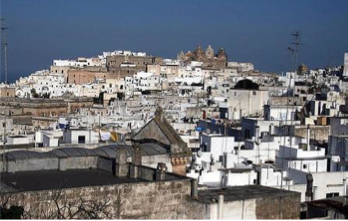 The municipal territory of Cisternino is south-west oriented over the splendid Itria Valley, known for the considerable presence of trulli, the local typical stone constructions.
The municipal territory of Cisternino is south-west oriented over the splendid Itria Valley, known for the considerable presence of trulli, the local typical stone constructions.
Inhabited since the Upper Paleolithic, the legend says that the foundation of Cisternino was due to Sturnoi, the companion of Diomedes. After taking part in the Messapic League against Taranto, it became a Roman town and was called Sturninum. It was probably destroyed in 216 B.C. during Hannibal‟ s raids in Apulia.
 A very picturesque local event is the Easter Monday’s feast, here called "A Pasquaredde", when the local population goes to the Sanctuary of the Madonna of Ibernia (Madonna de Bernis) with a bag-shaped cake containing two hard-boiled eggs for the boys and a dolly-shaped cake with one hard-boiled egg in the belly for the girls. This particular cake, called “u chrruchl", is meant to ensure fertility. The Sanctuary is also an interesting archaeological site where Roman and Medieval findings may be observed. Finally, the Norman-Swabian Tower or Torre di Porta Grande, is a considerable example of access way to the town.
A very picturesque local event is the Easter Monday’s feast, here called "A Pasquaredde", when the local population goes to the Sanctuary of the Madonna of Ibernia (Madonna de Bernis) with a bag-shaped cake containing two hard-boiled eggs for the boys and a dolly-shaped cake with one hard-boiled egg in the belly for the girls. This particular cake, called “u chrruchl", is meant to ensure fertility. The Sanctuary is also an interesting archaeological site where Roman and Medieval findings may be observed. Finally, the Norman-Swabian Tower or Torre di Porta Grande, is a considerable example of access way to the town. Ostuni
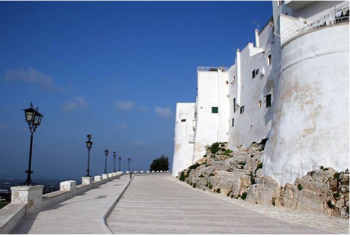 An important cultural centre in Salento, Ostuni is also known as the “white city” and it is located eight kilometers from the Adriatic coast, in the southern Murgia. The first settlement dates back to the 4th century B.C. and was established by the Messapi. Destroyed at the end of the Second Punic War, the town was rebuilt by the Romans under whom Ostuni flourished. A long period of alternating domination characterized the fall of the Roman Empire: the Ostrogoths, Longobards, Normans, Suevians, Angionians and Aragons followed one after another, but none managed to subject the town to feudal rule. After 1800 Ostuni extended its territory by joining the medieval town with its current territory. Recent archaeological finds confirm human settlements around Ostuni from as early as the Paleolithic. In particular, much interest surrounds the well-preserved remains of a woman in labour lying in a large hollow and with a type of hat made out of very small shells.
An important cultural centre in Salento, Ostuni is also known as the “white city” and it is located eight kilometers from the Adriatic coast, in the southern Murgia. The first settlement dates back to the 4th century B.C. and was established by the Messapi. Destroyed at the end of the Second Punic War, the town was rebuilt by the Romans under whom Ostuni flourished. A long period of alternating domination characterized the fall of the Roman Empire: the Ostrogoths, Longobards, Normans, Suevians, Angionians and Aragons followed one after another, but none managed to subject the town to feudal rule. After 1800 Ostuni extended its territory by joining the medieval town with its current territory. Recent archaeological finds confirm human settlements around Ostuni from as early as the Paleolithic. In particular, much interest surrounds the well-preserved remains of a woman in labour lying in a large hollow and with a type of hat made out of very small shells.
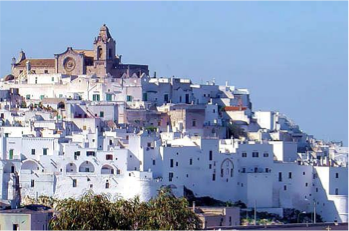 Ostuni’s charm lies in the characteristic white walls of the houses in the old town. Indeed all the houses in the historic centre are only painted using white lime paint. Due to this feature Ostuni is called "the white town", “the queen of the olive groves" and the "city of the crib". The entire old town, known as the “Terra” to distinguish it from the more recent "Marina", is worth a visit. The centre of the old town is crowned by Ostuni Cathedral, in a style difficult to classify, which is however traceable to the Gothic-Romanesque tradition, with Apulia hosting other examples of this architecture. Check out the large door of the Church of Spirito Santo which dates back to 1450 and was originally built for the Church of Ognissanti. It is today recognized as a national monument. Another attraction in Ostuni is the 17-km long coastline that alternates sandy little bays, rocks, pebble beaches and dunes covered in Mediterranean maquis. A huge attraction is the Festival of Sant’Oronzo, the patron saint of the town, which takes place from the 25th to the 27th of August and which also includes the “Cavalcata” in which the municipality authorities and representatives from the clergy parade on horseback alongside of dames and knights in medieval costumes.
Ostuni’s charm lies in the characteristic white walls of the houses in the old town. Indeed all the houses in the historic centre are only painted using white lime paint. Due to this feature Ostuni is called "the white town", “the queen of the olive groves" and the "city of the crib". The entire old town, known as the “Terra” to distinguish it from the more recent "Marina", is worth a visit. The centre of the old town is crowned by Ostuni Cathedral, in a style difficult to classify, which is however traceable to the Gothic-Romanesque tradition, with Apulia hosting other examples of this architecture. Check out the large door of the Church of Spirito Santo which dates back to 1450 and was originally built for the Church of Ognissanti. It is today recognized as a national monument. Another attraction in Ostuni is the 17-km long coastline that alternates sandy little bays, rocks, pebble beaches and dunes covered in Mediterranean maquis. A huge attraction is the Festival of Sant’Oronzo, the patron saint of the town, which takes place from the 25th to the 27th of August and which also includes the “Cavalcata” in which the municipality authorities and representatives from the clergy parade on horseback alongside of dames and knights in medieval costumes.
Locorotondo
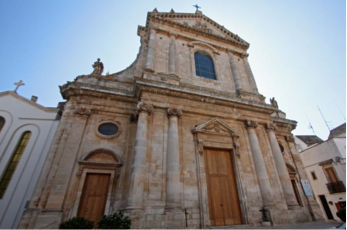 This town rises at the junction of three provinces: Bari, Taranto and Brindisi. It is placed in the Itria Valley, on a tableland 410m above sea level at the south-eastern side of Murge dei Trulli. Locorotondo was probably founded by Greek settlers several centuries before Christ. Early sources mentioning a feud named Rotondo date back to the 12th century. Around 1250, this village gradually grew and became a real hamlet subject to St. Stephen monastery. Between the 14th and 15th century, Locorotondo was a property of one of the greatest families of that era, Del Balzo Orsini. During the 16th century the town experienced an economic,
This town rises at the junction of three provinces: Bari, Taranto and Brindisi. It is placed in the Itria Valley, on a tableland 410m above sea level at the south-eastern side of Murge dei Trulli. Locorotondo was probably founded by Greek settlers several centuries before Christ. Early sources mentioning a feud named Rotondo date back to the 12th century. Around 1250, this village gradually grew and became a real hamlet subject to St. Stephen monastery. Between the 14th and 15th century, Locorotondo was a property of one of the greatest families of that era, Del Balzo Orsini. During the 16th century the town experienced an economic,
cultural and demographic turmoil. At the end of the 18th century Locorotondo participated in the risings following the ratification of the Roman and Neapolitan Republics.
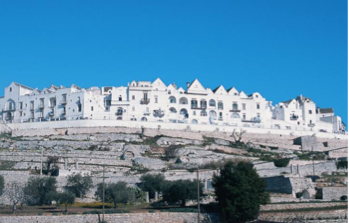 The Mother church is devoted to St. George and dates back to 17th century. It was built following the destruction of two previous places of worship. The dome was covered with a polychromatic glazed terracotta until 1841, when it was destroyed by a lightning and it was never fixed. Locorotondo has several churches, among which the church of Addolorata, the church of Holy Spirit, St. Nicholas, Annunziata, St. Rocco, Madonna della Catena. Inside the beautiful church of S. Maria della Greca, you can admire a valuable Renaissance polyptyc over the middle altar in memory of the Virgin of Roses as well as a sculptural set portraying St. George riding a horse. During the celebrations for St. Rocco, at midnight on the 16th of August, a very evocative firework competition takes place. Four competing companies usually take part in the event and the winning one repeats its pyrotechnic show at the end of the celebrations, the following night.
The Mother church is devoted to St. George and dates back to 17th century. It was built following the destruction of two previous places of worship. The dome was covered with a polychromatic glazed terracotta until 1841, when it was destroyed by a lightning and it was never fixed. Locorotondo has several churches, among which the church of Addolorata, the church of Holy Spirit, St. Nicholas, Annunziata, St. Rocco, Madonna della Catena. Inside the beautiful church of S. Maria della Greca, you can admire a valuable Renaissance polyptyc over the middle altar in memory of the Virgin of Roses as well as a sculptural set portraying St. George riding a horse. During the celebrations for St. Rocco, at midnight on the 16th of August, a very evocative firework competition takes place. Four competing companies usually take part in the event and the winning one repeats its pyrotechnic show at the end of the celebrations, the following night.
Alberobello
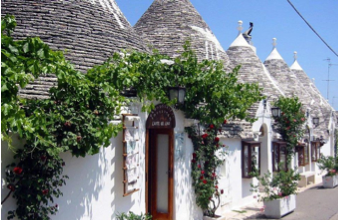 Alberobello is renowned for the iconic Trulli, a traditional stone building, invented in the 15th century to avoid paying taxes to the King. The Trulli, with their distinctive cone-shaped roof, are unique to the Itria valley in Italy and were built using no mortar. In Alberobello you can visit Aia Piccola, a district where about 400 Trulli are concentrated. The homes are still lived in, creating a wonderful atmosphere as you wander the lanes admiring the history of the area and talking to the friendly locals. The beautiful Basilica Minore was built in 1926 by architect Antonio Curri in a neo-classical style, and nearby there is the Trullo Sovrano, a modern Trullo house. Built with two-stores, several fireplaces, kitchen equipment and looms, this house looks like a mansion compared to the much simpler trulli in the area.
Alberobello is renowned for the iconic Trulli, a traditional stone building, invented in the 15th century to avoid paying taxes to the King. The Trulli, with their distinctive cone-shaped roof, are unique to the Itria valley in Italy and were built using no mortar. In Alberobello you can visit Aia Piccola, a district where about 400 Trulli are concentrated. The homes are still lived in, creating a wonderful atmosphere as you wander the lanes admiring the history of the area and talking to the friendly locals. The beautiful Basilica Minore was built in 1926 by architect Antonio Curri in a neo-classical style, and nearby there is the Trullo Sovrano, a modern Trullo house. Built with two-stores, several fireplaces, kitchen equipment and looms, this house looks like a mansion compared to the much simpler trulli in the area.
 A recommended visit is Casa D'Amore, a UNESCO World Cultural Heritage monument. For over a century the Acquaviva Counts of Conversano wanted all the structures to be built in the classical trullo shape. Casa D’Amore was the first monument in Alberobello to be erected with mortar and without the classical Trullo shape. Rione Monti is the old town center. With more than 1,000 trulli along seven different roads, this is a highly picturesque area. Here you find traditional food and drink to indulge in and many workshop owners showing the production of their handmade articles. Don't miss the church of St. Antonio, set in the heart of Rione Monti.
A recommended visit is Casa D'Amore, a UNESCO World Cultural Heritage monument. For over a century the Acquaviva Counts of Conversano wanted all the structures to be built in the classical trullo shape. Casa D’Amore was the first monument in Alberobello to be erected with mortar and without the classical Trullo shape. Rione Monti is the old town center. With more than 1,000 trulli along seven different roads, this is a highly picturesque area. Here you find traditional food and drink to indulge in and many workshop owners showing the production of their handmade articles. Don't miss the church of St. Antonio, set in the heart of Rione Monti.
Brindisi
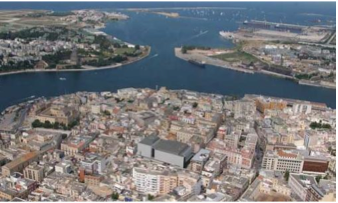 Brindisi is in the Salento plains and on the Adriatic sea, with a natural harbour jutting into the land and whose deer-like shape determined the name of the town. It was once the main base of the Messapian civilization, always conflicted with neighboring Taranto and it was conquered by the Romans in 267 B.C. Connected to the capital of the Empire by via Appia and via Traiana, it was an extremely important trading centre and episcopal base from the start of the apostolic age. Brindisi shared then the fate of all the towns in the Region and it was ruled by Byzantines, Normans,
Brindisi is in the Salento plains and on the Adriatic sea, with a natural harbour jutting into the land and whose deer-like shape determined the name of the town. It was once the main base of the Messapian civilization, always conflicted with neighboring Taranto and it was conquered by the Romans in 267 B.C. Connected to the capital of the Empire by via Appia and via Traiana, it was an extremely important trading centre and episcopal base from the start of the apostolic age. Brindisi shared then the fate of all the towns in the Region and it was ruled by Byzantines, Normans,
Swabians, Angevins and Aragons. Its port was conquered by the Venetian marine Republic and then subject to the control of Naples. Its period of greatest glory was during the Unification of Italy (1861), and then for five months between 1943 and 1944, when Brindisi even played a role as capital of Italy.
 An absolute must see in Brindisi is the Aragon Castle, a “sea fort” built in 1491 on the island facing the harbor in order to defend the town. The Castle is divided in two parts: the “Red Castle”, made of red stone, and the Fort, used to house the garrisons. The town‟ s second fort is the Swabian Castle or “Large Castle”: it was built under the order of Frederick II as a fortified residence for the garrisons. In the San Pietro degli Schiavoni district, worth visiting is the archaeological area with its Roman zone, including a thermal spa, houses and streets. Nearby there are also five lime baths to filter drinkable water. Beside San Vito Street there is the Tancredi Fountain, erected under the order of Emperor Tancredi in 1192 to celebrate the marriage of his son Ruggero to Irene, the daughter of the Emperor of Constantinople. Traditional rites worth attending include the sea Procession of Patron Saints during the first week of September, the Adorned Horse of Corpus Domini and Osanna, a religious rite of Greek origins that has taken place ever since the half of the 10th century.
An absolute must see in Brindisi is the Aragon Castle, a “sea fort” built in 1491 on the island facing the harbor in order to defend the town. The Castle is divided in two parts: the “Red Castle”, made of red stone, and the Fort, used to house the garrisons. The town‟ s second fort is the Swabian Castle or “Large Castle”: it was built under the order of Frederick II as a fortified residence for the garrisons. In the San Pietro degli Schiavoni district, worth visiting is the archaeological area with its Roman zone, including a thermal spa, houses and streets. Nearby there are also five lime baths to filter drinkable water. Beside San Vito Street there is the Tancredi Fountain, erected under the order of Emperor Tancredi in 1192 to celebrate the marriage of his son Ruggero to Irene, the daughter of the Emperor of Constantinople. Traditional rites worth attending include the sea Procession of Patron Saints during the first week of September, the Adorned Horse of Corpus Domini and Osanna, a religious rite of Greek origins that has taken place ever since the half of the 10th century.
